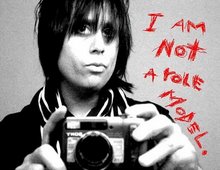The following is a short boigraphy on Nikola Tesla, the founder of modern electricity and regarded by some as the 'Father of Physics'.

NIKOLA TESLA
(b. July 9/10, 1856, Smiljan, Croatia--d. Jan. 7, 1943, New York City),
Serbian-American inventor and researcher who discovered the rotating magnetic field, the basis of most alternating-current machinery. He emigrated to the United States in 1884 and sold the patent rights to his system of alternating-current dynamos, transformers, and motors to George Westinghouse the following year. In 1891 he invented the Tesla coil, an induction coil widely used in radio technology.
Tesla was from a family of Serbian origin. His father was an Orthodox priest; his mother was unschooled but highly intelligent. A dreamer with a poetic touch, as he matured Tesla added to these earlier qualities those of self-discipline and a desire for precision.
Training for an engineering career, he attended the Technical University at Graz, Austria, and the University of Prague. At Graz he first saw the Gramme dynamo, which operated as a generator and, when reversed, became an electric motor, and he conceived a way to use alternating current to advantage. Later, at Budapest, he visualized the principle of the rotating magnetic field and developed plans for an induction motor that would become his first step toward the successful utilization of alternating current. In 1882 Tesla went to work in Paris for the Continental Edison Company, and, while on assignment to Strassburg in 1883, he constructed, in after-work hours, his first induction motor. Tesla sailed for America in 1884, arriving in New York, with four cents in his pocket, a few of his own poems, and calculations for a flying machine. He first found employment with Thomas Edison, but the two inventors were far apart in background and methods, and their separation was inevitable.
In May 1885, George Westinghouse, head of the Westinghouse Electric Company in Pittsburgh, bought the patent rights to Tesla's polyphase system of alternating-current dynamos, transformers, and motors. The transaction precipitated a titanic power struggle between Edison's direct-current systems and the Tesla-Westinghouse alternating-current approach, which eventually won out.
Tesla soon established his own laboratory, where his inventive mind could be given free rein. He experimented with shadowgraphs similar to those that later were to be used by Wilhelm Röntgen when he discovered X-rays in 1895. Tesla's countless experiments included work on a carbon button lamp, on the power of electrical resonance, and on various types of lighting.
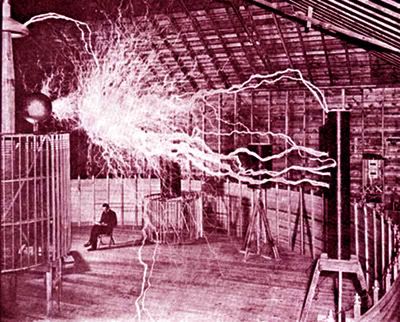
Tesla gave exhibitions in his laboratory in which he lighted lamps without wires by allowing electricity to flow through his body, to allay fears of alternating current. He was often invited to lecture at home and abroad. The Tesla coil, which he invented in 1891, is widely used today in radio and television sets and other electronic equipment. That year also marked the date of Tesla's United States citizenship.
Westinghouse used Tesla's system to light the World's Columbian Exposition at Chicago in 1893. His success was a factor in winning him the contract to install the first power machinery at Niagara Falls, which bore Tesla's name and patent numbers. The project carried power to Buffalo by 1896.
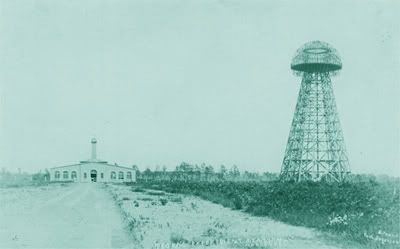
In 1898 Tesla announced his invention of a teleautomatic boat guided by remote control. When skepticism was voiced, Tesla proved his claims for it before a crowd in Madison Square Garden.
In Colorado Springs, Colo., where he stayed from May 1899 until early 1900, Tesla made what he regarded as his most important discovery-- terrestrial stationary waves. By this discovery he proved that the Earth could be used as a conductor and would be as responsive as a tuning fork to electrical vibrations of a certain frequency. He also lighted 200 lamps without wires from a distance of 25 miles (40 kilometres) and created man-made lightning, producing flashes measuring 135 feet (41 metres). At one time he was certain he had received signals from another planet in his Colorado laboratory, a claim that was met with derision in some scientific journals.
Returning to New York in 1900, Tesla began construction on Long Island of a wireless world broadcasting tower, with $150,000 capital from the American financier J. Pierpont Morgan. Tesla claimed he secured the loan by assigning 51 percent of his patent rights of telephony and telegraphy to Morgan. He expected to provide worldwide communication and to furnish facilities for sending pictures, messages, weather warnings, and stock reports. The project was abandoned because of a financial panic, labour troubles, and Morgan's withdrawal of support. It was Tesla's greatest defeat.
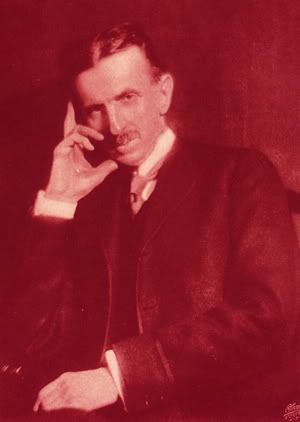
Tesla's work then shifted to turbines and other projects. Because of a lack of funds, his ideas remained in his notebooks, which are still examined by engineers for unexploited clues. In 1915 he was severely disappointed when a report that he and Edison were to share the Nobel Prize proved erroneous. Tesla was the recipient of the Edison Medal in 1917, the highest honour that the American Institute of Electrical Engineers could bestow.
Tesla allowed himself only a few close friends. Among them were the writers Robert Underwood Johnson, Mark Twain, and Francis Marion Crawford. He was quite impractical in financial matters and an eccentric, driven by compulsions and a progressive germ phobia. But he had a way of intuitively sensing hidden scientific secrets and employing his inventive talent to prove his hypotheses. Tesla was a godsend to reporters who sought sensational copy but a problem to editors who were uncertain how seriously his futuristic prophecies should be regarded. Caustic criticism greeted his speculations concerning communication with other planets, his assertions that he could split the Earth like an apple, and his claim of having invented a death ray capable of destroying 10,000 airplanes at a distance of 250 miles (400 kilometres).
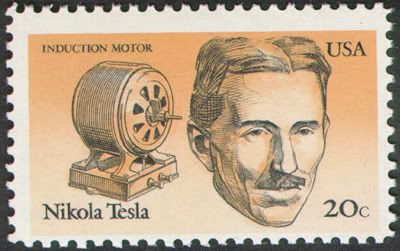
After Tesla's death the custodian of alien property impounded his trunks, which held his papers, his diplomas and other honours, his letters, and his laboratory notes. These were eventually inherited by Tesla's nephew, Sava Kosanovich, and later housed in the Nikola Tesla Museum in Belgrade. Hundreds filed into New York City's Cathedral of St. John the Divine for his funeral services, and a flood of messages acknowledged the loss of a great genius. Three Nobel Prize recipients addressed their tribute to "one of the outstanding intellects of the world who paved the way for many of the technological developments of modern times." (I.W.H.)

TIMELINE:
1856 – He was born on the 10th day of July of this year in Smiljan, Military Frontier, Austrian Empire. His baptism certificate reports that he was born on June 28, 1856, and christened by the Serbian Orthodox priest Toma Oklobdžija. His father was Rev. Milutin Tesla, a priest in the Serbian Orthodox Church Metropolitanate of Sremski Karlovci. His mother was uka Mandi, herself a daughter of a Serbian Orthodox Church priest.
1862 - His family moved to Gospi in this year. Tesla went to school in Karlovac. He finished a four year term in the span of three years
1875 - Tesla then studied electrical engineering at the Austrian Polytechnic in Graz. While there, he studied the uses of alternating current. Some sources say he received Baccalaureate degrees from the university at Graz.
1880 - Tesla was later persuaded by his father to attend the Charles-Ferdinand University in Prague, which he attended for the summer term of 1880. However after his father died he left the university, only completing one term.
1881 – He moved to Budapest, Hungary, to work under Tivadar Puskás in a telegraph company, the National Telephone Company. There, he met Nebojša Petrovi, a young inventor from Austria. Although their encounter was brief, they did work on a project together using twin turbines to create continual power. On the opening of the telephone exchange in Budapest, Tesla became the chief electrician to the company, and was later engineer for the country's first telephone system.
1882 – He moved to Paris, France to work as an engineer for the Continental Edison Company, designing improvements to electric equipment. In the same year, Tesla conceived of the induction motor and began developing various devices that use rotating magnetic fields for which he received patents in 1888.
1884 - On the 6th day of June of this year, Tesla first arrived in the US in New York City. He had little besides a letter of recommendation from Charles Batchelor, his manager in his previous job.
1886 – He formed his own company, Tesla Electric Light & Manufacturing. The initial financial investors disagreed with Tesla on his plan for an alternating current motor and eventually relieved him of his duties at the company. Tesla worked in New York as a common laborer from 1886 to 1887 to feed himself and raise capital for his next project.
1887 – He constructed the initial brushless alternating current induction motor, which he demonstrated to the American Institute of Electrical Engineers (now IEEE) in 1888. In the same year, he developed the principles of his Tesla coil and began working with George Westinghouse at Westinghouse Electric & Manufacturing Company's Pittsburgh labs.
1887 - Tesla began investigating what would later be called X-rays using his own single node vacuum tubes (similar to his patent #514,170 ). This device differed from other early X-ray tubes in that they had no target electrode.
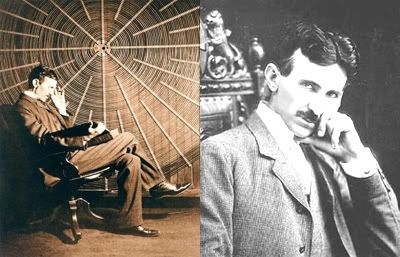
1891 – He became a naturalized citizen of the United States at the age of 35. Tesla established his 35 South Fifth Avenue laboratory in New York during this same year. Later, Tesla would establish his Houston Street laboratory in New York at 46 E. Houston Street.
1892 - Tesla served, from this year to 1894, as the vice president of the American Institute of Electrical Engineers, the forerunner (along with the Institute of Radio Engineers) of the modern-day IEEE.
1893 - From this year to 1895, he investigated high frequency alternating currents. After his demonstration of wireless communication in this year and after being the victor in the "War of Currents", he was widely respected as America's greatest electrical engineer.
1899 – He decided to move and began research in Colorado Springs, Colorado, where he would have room for his high-voltage, high-frequency experiments. Upon his arrival, he told reporters that he was conducting wireless telegraphy experiments transmitting signals from Pikes Peak to Paris.
1900 – With $150,000 (51% from J. Pierpont Morgan), Tesla began planning the Wardenclyffe Tower facility.
1902 - In June of this year, Tesla's lab operations were moved to Wardenclyffe from Houston Street. The tower was finally dismantled for scrap during World War 1. Newspapers of the time labeled Wardenclyffe "Tesla's million-dollar folly."
1904 - The US Patent Office reversed its decision and awarded Guglielmo Marconi the patent for radio, and Tesla began his fight to re-acquire the radio patent. On his 50th birthday in 1906, Tesla demonstrated his 200 hp (150 kW) 16,000-rpm bladeless turbine.
1910 - During 1910–1911 at the Waterside Power Station in New York, several of his bladeless turbine engines were tested at 100–5000 hp.
1915 – He filed a lawsuit against Marconi attempting, unsuccessfully, to obtain a court injunction against the claims of Marconi. After Wardenclyffe, Tesla built the Telefunken Wireless Station in Sayville, Long Island. Some of what he wanted to achieve at Wardenclyffe was accomplished with the Telefunken Wireless.
1917 – The facility was seized and torn down by the Marines, because it was suspected that German spies could use it.
1916 – He was awarded with an Edison Medal this year.
1943 – He died on the 7th day of January of this year. 1943, the Supreme Court of the United States credited him as being the inventor of the radio. Many of his achievements have been used, with some controversy, to support various pseudosciences, UFO theories and new age occultism.
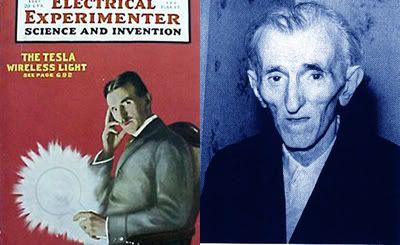
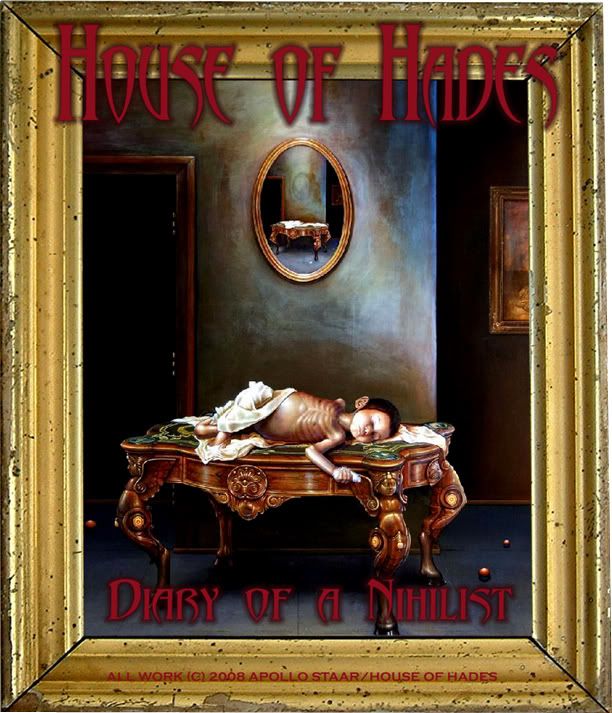 this blog is dedicated to showcasing obscure rare and transgressive film video literature art and people including interviews reviews observations and anything else that I consider noteworthy and/or unconstitutional and deemed sinful or immoral by any religious right. I welcome you to send me queries comments or criticisms. -A.S.
this blog is dedicated to showcasing obscure rare and transgressive film video literature art and people including interviews reviews observations and anything else that I consider noteworthy and/or unconstitutional and deemed sinful or immoral by any religious right. I welcome you to send me queries comments or criticisms. -A.S.







